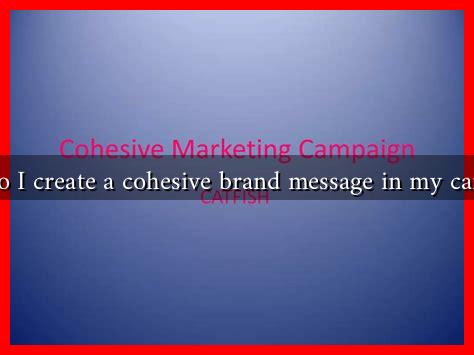-
Table of Contents
How Do I Create a Cohesive Brand Message in My Campaign?
In today’s competitive marketplace, a cohesive brand message is essential for any successful marketing campaign. A well-defined brand message not only communicates your values and mission but also resonates with your target audience, fostering loyalty and trust. This article will guide you through the steps to create a cohesive brand message that aligns with your campaign goals.
Understanding Your Brand Identity
Before crafting a brand message, it’s crucial to understand your brand identity. This includes your brand’s mission, vision, values, and personality. A clear understanding of these elements will serve as the foundation for your messaging.
- Mission: What is the purpose of your brand? What problems do you solve?
- Vision: Where do you see your brand in the future? What impact do you want to make?
- Values: What principles guide your brand’s actions and decisions?
- Personality: How do you want your brand to be perceived? Is it friendly, professional, quirky, or authoritative?
For example, Nike’s mission is to bring inspiration and innovation to every athlete in the world. This mission is reflected in their messaging, which often emphasizes empowerment and achievement.
Identifying Your Target Audience
Understanding your target audience is critical for creating a cohesive brand message. Knowing who you are speaking to will help you tailor your message to resonate with their needs, preferences, and pain points.
- Demographics: Age, gender, income level, education, etc.
- Psychographics: Interests, values, lifestyle, and behavior.
- Challenges: What problems does your audience face that your brand can solve?
For instance, Dove’s “Real Beauty” campaign effectively targeted women of all shapes and sizes, promoting self-esteem and body positivity. This approach resonated deeply with their audience, leading to increased brand loyalty.
Crafting Your Brand Message
Once you have a clear understanding of your brand identity and target audience, it’s time to craft your brand message. Here are some key components to consider:
- Clarity: Your message should be straightforward and easy to understand.
- Consistency: Use the same tone, language, and style across all platforms.
- Emotion: Connect with your audience on an emotional level to foster engagement.
- Call to Action: Encourage your audience to take a specific action, whether it’s visiting your website or making a purchase.
For example, Apple’s brand message revolves around innovation and simplicity. Their campaigns consistently highlight these themes, making it easy for consumers to understand what the brand stands for.
Utilizing Multiple Channels
To ensure your brand message reaches your audience effectively, utilize multiple channels. This includes social media, email marketing, content marketing, and traditional advertising. Each channel should reflect your cohesive brand message while adapting to the specific format and audience of that platform.
- Social Media: Use engaging visuals and concise messaging to capture attention.
- Email Marketing: Personalize your messages to create a connection with your audience.
- Content Marketing: Provide valuable content that aligns with your brand message and addresses audience needs.
- Traditional Advertising: Ensure your messaging is consistent across print, radio, and TV ads.
For instance, Coca-Cola’s “Share a Coke” campaign successfully utilized social media, print, and outdoor advertising to create a unified message that encouraged sharing and connection.
Measuring Success and Adjusting Your Message
Finally, it’s essential to measure the success of your brand message and make adjustments as needed. Use analytics tools to track engagement, conversion rates, and customer feedback. This data will help you refine your messaging and ensure it remains relevant to your audience.
According to a study by HubSpot, companies that prioritize customer experience can see a 60% increase in customer loyalty. This highlights the importance of continuously evaluating and adjusting your brand message to meet audience expectations.
Conclusion
Creating a cohesive brand message is a vital component of any successful marketing campaign. By understanding your brand identity, identifying your target audience, crafting a clear and emotional message, utilizing multiple channels, and measuring success, you can develop a brand message that resonates with your audience and drives engagement. Remember, consistency is key—your brand message should reflect your values and mission across all platforms. With these strategies in mind, you can create a powerful brand message that stands out in today’s crowded marketplace.
For further reading on brand messaging strategies, check out this article on Forbes.

